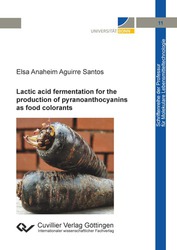| Areas | |
|---|---|
| Serie de libros (96) |
1378
|
| Nachhaltigkeit |
3
|
| Gesundheitswesen |
1
|
| Letra |
2364
|
| Ciencias Naturales |
5406
|
| Matemática | 229 |
| Informática | 319 |
| Física | 980 |
| Química | 1363 |
| Geociencias | 131 |
| Medicina humana | 243 |
| Estomatología | 10 |
| Veterinaria | 108 |
| Farmacia | 147 |
| Biología | 835 |
| Bioquímica, biología molecular, tecnología genética | 121 |
| Biofísica | 25 |
| Nutrición | 45 |
| Agricultura | 1004 |
| Silvicultura | 201 |
| Horticultura | 20 |
| Ecología y conservación de la tierra | 148 |
| Ciencias Ingeniería |
1793
|
| General |
98
|
|
Leitlinien Unfallchirurgie
5. Auflage bestellen |
|
Erweiterte Suche
Lactic acid fermentation for the production of pyranoanthocyanins as food colorants (Volumen 11) (Tienda española)
Elsa Anaheim Aguirre Santos (Autor)Previo
Lectura de prueba, PDF (190 KB)
Indice, PDF (100 KB)
The long-discussed safety of synthetic colorants and the demand of customers for more healthy and natural products have resulted in research on natural sources to substitute those artificial colorants. Among natural alternatives, anthocyanins are well-known, nevertheless their use is limited to acidic products due to their poor stability at higher pH and elevated temperatures. Black carrot juice is a remarkable coloring food product mainly used since it has been reported to be a rich source of highly stable acylated anthocyanins and phenolic acids. Pyranoanthocyanins are pigments presented in processed fruit products like juices and wines. The enhanced stability of pyranoanthocyanins at different pH-values renders them as good candidates to be used as natural food colorant. They are reaction products of anthocyanins and different compounds from microbial metabolism. Due to the phenolic composition presented by black carrots, they are a good source of precursors for the synthesis of pyranoanthocyanins. These precursors are anthocyanins and hydroxycinnamic acids. As hydroxycinnamic acids are predominantly bound to quinic acid or sugars, cinnamoyl esterase activity is necessary. Therefore, lactic acid bacteria, able to hydrolyze the ester bond and release the free acids were used. Once released, the hydroxycinnamic acids can be converted into vinylphenols by a second group of LAB displaying hydroxycinnamate decarboxylase enzymes. The formed products react with the anthocyanins to pyranoanthocyanins. The process reported in this study thus demonstrates a very attractive approach to formulate a coloring foodstuff highly stable to be used for the food industry.
Die viel diskutierten Sicherheitsbedenken bezüglich der Nutzung von synthetischen Farbstoffen und die Nachfrage von Konsumenten nach gesünderen und natürlicheren Produkten fördert die Forschung nach alternativen Farbstoffen natürlichen Ursprungs. Anthocyane stellen eine bekannte Alternative zu synthetischen Farbstoffen dar. Ihr Einsatzgebiet ist aufgrund der geringen Prozessstabilität jedoch auf Produkte mit einem hohen Säuregehalt beschränkt. Schwarzer Karottensaft wird bereits als Färbendes Lebensmittel eingesetzt, da er reich an hochstabilen acylierten Anthocyanen und Phenolsäuren ist. Pyranoanthocyane sind Farbpigmente, die in verarbeiteten Fruchtprodukten vorkommen, wie z.B. in Säften oder in Weinen. Sie eignen sich für die Verwendung als Lebensmittelfarbstoff, da sie eine hohe Stabilität bei verschiedenen pH-Werten aufweisen. Im mikrobiellen Organismus entstehen Pyranoanthocyane als Reaktionsprodukte bei der Reaktion von Anthocyanen mit Metaboliten des mikrobiellen Stoffwechsels. Vorstufen für die Gewinnung von Pyranoanthocyanen sind Anthocyane und u.a. Hydroxyzimtsäuren. Beide finden sich neben anderen phenolischen Inhaltsstoffen in der schwarzen Karotte. Hydroxyzimtsäuren liegen in dieser zum größten Teil an Chinasäure oder Zucker gebunden vor. Die vorliegende Studie beschreibt somit einen sehr attraktiven Ansatz für die Gewinnung von stabilen Farbstoffen natürlichen Ursprungs, die in der Lebensmittelindustrie verwendet werden können.
| ISBN-13 (Impresion) | 9783736975538 |
| ISBN-13 (E-Book) | 9783736965539 |
| Formato | A5 |
| Idioma | Inglés |
| Numero de paginas | 176 |
| Laminacion de la cubierta | mate |
| Edicion | 1. |
| Serie | Schriftenreihe der Professur für Molekulare Lebensmitteltechnologie |
| Volumen | 11 |
| Lugar de publicacion | Göttingen |
| Lugar de la disertacion | Bonn |
| Fecha de publicacion | 27.12.2021 |
| Clasificacion simple | Tesis doctoral |
| Area |
Química de alimentación
|
| Palabras claves | lactic acid bacteria, black carrots, Black carrot juice, fermentation, synthetic colorants, artificial colorants, natural food colorant, anthocyanins, phenolic acids, Pyranoanthocyanins, pH-values, microbial metabolism, phenolic composition, hydroxycinnamic acids, quinic acid, cinnamoyl esterase activity, hydroxycinnamic acids, vinylphenols, LAB displaying hydroxycinnamate decarboxylase enzymes, coloring foodstuff, food industry, synthetische Farbstoffe, künstliche Farbstoffe, Farbstoffe natürlichen Ursprungs, Anthocyane, schwarzer Karottensaft, schwarze Karotten, Phenolsäuren, Pyranoanthocyane, pH-Werte, mikrobieller Organismus, Hydroxyzimtsäuren, Lebensmittelindustrie, Lebensmittel, food, Kaffeesäure, caffeic acid, Zimtsäure, cinnamic acid, Geschmackswahrnehmung, Safran, Indigo, Cochenille, food adulteration, Lebensmittelzusatzstoffe, food additives, Clean Kennzeichnung, clean labeling, Konservierungsmittel, preservatives, E-Nummer, E number, Biotechnologie, biotechnology, Lebensmittelextrakt, food extract, Biofarben, biocolors, geringe Stabilität, low stability, gesundheitliche Vorteile, health benefits, Entzündungshemmer, antiinflammatory, harmful to health, gesundheitsschädlich, Qualitätserwartung, quality expectations, umweltfreundlich, eco-friendly alternative, agriculture, Landwirtschaft |








